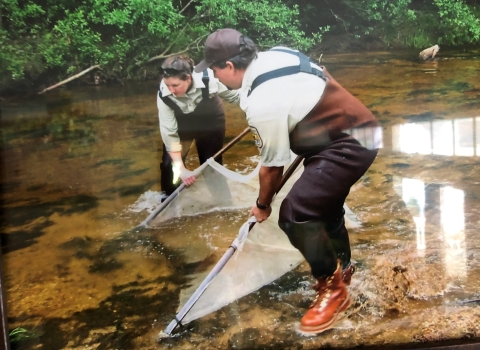World Migratory Bird Day
In 2023, World Migratory Bird Day will be celebrated on May 13 in the spring and October 14 in fall. The conservation theme this year is Water: Sustaining Bird Life, and focuses on the importance of water to migratory birds.
Virtually all migratory birds rely on water and some type of wetland habitat at some point during their life cycles. Lakes, rivers, streams, ponds, wetlands, coastal marshes, and oceans are vital for feeding, drinking, or nesting, and are extremely important as places to rest and refuel during migration.
Aquatic ecosystems are becoming increasingly threatened around the world, and so too are the migratory birds that depend on them. The increasing human demand for water, as well as pollution and the impacts of climate change climate change
Climate change includes both global warming driven by human-induced emissions of greenhouse gases and the resulting large-scale shifts in weather patterns. Though there have been previous periods of climatic change, since the mid-20th century humans have had an unprecedented impact on Earth's climate system and caused change on a global scale.
Learn more about climate change , are having a direct impact on the quantity and quality of water resources and on the conservation status of many migratory bird species.
Water, Climate Change and Birds
In some areas, the lack of water and prolonged droughts may be impacting birds. In other areas, the impacts of sea level rise from climate change may be affecting birds.
The impacts of a changing climate on birds are widespread and far-reaching. In fact, because birds are relatively well studied and mobile, they are some of the earliest and best indicators of climate change. Climate change affects the timing of migration, the resources available to birds to feed, rest and breed, and the range of suitable habitat where they can breed and winter. Here are just a handful of examples of birds that we know are struggling with the impacts of climate change:
- In the Gulf of Maine, puffins are having difficulty finding their major food sources of white hake and herring. As the sea warms, the fish are moving into deeper waters or further north, making it harder for puffins to catch a meal and feed their young. Adult puffins are compensating by feeding their young butterfish, but young puffins are unable to swallow these large fish and many are dying of starvation. Delayed breeding seasons, low birth rates, and poor chick survival are all affecting the reproductive ability of these birds.
- Piping plovers are an iconic shorebird that breeds and nests along the Atlantic Coast, the Great Lakes and the Great Plains. Increased human use of their beach habitats, including intense coastal development, as well as rising sea levels and storm surges associated with climate change threaten the species.
- With less precipitation in the prairies and drier landscapes across the West, we are already witnessing an increase in wildfires that threaten both grassland and forest dependent birds, including Townsend’s warblers and golden-crowned kinglets.
- Service staff have been working to translocate seabirds, including Laysan albatross, black-footed albatross, and Bonin petrel, in the Pacific Islands from low-lying areas to higher grounds. This is part of an effort to ameliorate climate change impacts to these species, including warming and rising oceans, the availability of nesting habitat, and the ability to find their prey fish.
- In Louisiana, the state facing the highest coastal wetland loss rate of any state in country, about $80 million and 80 projects have been put on-the-ground to enhance, restore, and protect coastal marshes in Cameron Parish through the North American Wetlands Conservation Act grants. By working to offset the dramatic coastal wetland loss in the Chenier Plain, we can provide quality habitat for numerous bird species and other wetland dependent wildlife.
By protecting aquatic ecosystems, we can protect both the quantity and quality of water for all species, especially in light of the all the uncertainty we face from the impacts of climate change.
Join the Effort to Protect Water and Birds
We hope that you’ll join us in the international effort to celebrate “Water: Sustaining Bird Life.” There are many ways that you can participate in events that celebrate birds and all the joy they bring to us, including virtual webinars, birding events, and spring festivals. Find what kinds of events are happening in your area.
We will continue to post opportunities here with events that our very own U.S. Fish and Wildlife Service offices are hosting.
- Leavenworth National Fish Hatchery in Washington state is hosting a suite of activities May 18-20 for visitors for participate in and enjoy the birds around the hatchery.
- Muscatatuck National Wildlife Refuge in Indiana is hosting Wings over Muscatatuck. They will have bird walks, live birds-of-prey programs, guided van tours to a bald eagle nest, birdhouse building for youngsters, the Junior Duck Stamp contest awards ceremony, children's activities, a bat program, and much more.
- Join the Friends of Hackmatack National Wildlife Refuge in Illinois on April 30th and May 7th, 2023 for a 2-day bird festival, including fun family activities to learn more about birds.
- The public of all ages are invited to learn more about birds, pollinators and native plants at Sherburne National Wildlife Refuge in Minnesota! This drop-in style event will be mostly outdoors and includes a live bee display, interpretive booths, nature crafts, a story walk, binocular station, the Friends of Sherburne silent auction, the Eagle's Nest Nature Store and a local food truck.
- Horicon National Wildlife Refuge in Wisconsin is hosting a Marsh Bird Festival May 12th - May 14th. Visitors can enjoy guided birding hikes, bus tours, paddling and bicycle tours, kid’s activities and special exhibits.







